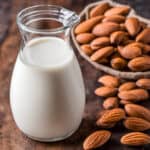
KEY TAKEAWAY
Which kidney bean variety is higher in protein content, white or red, and how can this impact my dietary choices?
Red kidney beans contain a slightly higher protein content than white kidney beans, making them a preferred choice for individuals seeking protein-rich food options. (1) This knowledge can help you make informed dietary decisions based on your protein requirements.
White vs Red Kidney Beans: An Inside Look at These Legumes
1. Nutritional differences between red and white beans
Both red and white beans provide admirable nutrition like dietary fiber, protein and vitamins/minerals. However, they vary slightly. Red beans contain around 15 grams of proteinand fiber per cup serving. They also offer more vitamin B1and B6 along with manganese, iron, magnesium and phosphorus compared to white beans.
White beans like cannellini have a richer, creamier texture but offer around 6-7 grams of fiber per cup. Their vitamin/mineral content provides noteworthy amounts of pantothenic acid and potassium yet remains comparable to red beans overall.
Interestingly, red beans feature a lower glycemic indexmeaning they cause smaller fluctuations in blood sugar levelsthan white beans after eating. This makes reds potentially better for blood sugar control.
2. Uses in cooking
While both add flavor, red beans commonly star in red beans and rice keeping their deep red hue and holding shape when cooked. White beans like navy or great northern take on flavors beautifully in soups, stews and creamy dips/spreads due to their velvety texture post-cooking.
Dried beans don’t cost much and canned varieties are pre-cooked for convenience. During the cooking process, red beans retain nutrition best while canned beans are already cooked. Canned varieties offer a shortcut yet contain more sodium, so rinsing helps reduce the risk of high blood pressure.
3. Health perks beyond nutrition
In addition to balanced vitamins, minerals and protein, beans provide filling dietary fiber. One daily cup helps weight management due to fiber’s ability to promote satiety. The soluble fiber in beans also supports healthy blood sugar levelsalong with cholesterol control.
Fiber, protein and other nutrients in beans work together. Eating beans regularly may reduce the risk of serious health issues like heart disease, diabetes or certain cancersaccording to ongoing studies.
4. Pick your favorite variety
Whether investing in dried or canned beans, let personal flavor profile and intended recipes guide your choice. Red beans, navy or black beans often suit heartier dishes while cannellini or great northern create amazing dips and spreads. In the end, thanks to balanced nutrition, any variety of beans contributes to better long-term health!
How to Cook White and Red Kidney Beans Perfectly
Soaking and Prep
- Rinse kidney beans (white or red) under cool water and pick out any stones or debris
- Place beans in a pot and cover with 2-3 inches of water
- Soak overnight for 12 hours or boil for 5 minutes then soak for 1 hour
- Drain and rinse beans after soaking is complete
Cooking Methods
- In a large pot, combine soaked beans and fresh water by a few inches over the beans
- Add seasonings like bay leaves, thyme, salt, pepper
- Bring to a boil then reduce heat and simmer for 1-2 hours until tender
- Check beans occasionally and add more water if needed to keep submerged
Pressure Cooker Method
- Add drained beans and fresh water to pressure cooker
- Cook at high pressure for 30 minutes for dried beans, 10 minutes for soaked
- Allow pressure to release naturally for creamier texture beans
Tips for Perfect Beans
- Using softened water makes for more tender beans
- Frozen beans can be cooked without soaking to save time
- Add vegetables and spices like cumin for flavor
- Undercook beans slightly if using in slow cooker recipes
Whether choosing white or red, following these steps is sure to yield perfectly cooked kidney beans every time!
Maximizing the Health Benefits of White and Red Kidney Beans
When enjoying beans, (2) include a small amount of fat such as olive oil or avocado. Fat-soluble vitamins like vitamin E require dietary fat to be absorbed by the body. A teaspoon of fat with beans enhances their nutritional value.
Eat a variety of bean types like red kidney, white kidney, black beans and more. Different beans supply unique phytonutrients and plant compounds. Including a mix of beans ensures receiving the full spectrum of nutrients.
Pair beans with whole grains such as brown rice or quinoa to form complete plant-based proteins. Also combine beans with vitamin C-rich foods to help iron absorption. Tomatoes, peppers or citrus work well alongside beans.
Soaking dried beans for one to two days before cooking aids nutrient availability. Soaking pre-digests components to make minerals and vitamins easier for the body to utilize from beans. This improves the nutrition one gains from beans in meals.
Which Bean is Best for Your Diet and Lifestyle?

Kidney beans, white beans, pinto beans, and black beans all have great health benefits and can fit well into a balanced diet. Here are some tips on picking the right beans for you:
Kidney Beans
Dark red kidney beans are packed with fiber, protein, iron, and B vitamins. They help regulate blood sugar levels. Kidney beans are great in chili, salads, and rice dishes. Limit kidney beans if you have digestive issues. They contain lectins which can cause gas and bloating if undercooked.
White Beans
White beans like cannellini and great northern have a creamy texture. They are an excellent source of plant-based protein and fiber. White beans can help lower cholesterol. Try white beans in soups, dips like hummus, or pasta salads. They have a milder flavor than other beans.
Black Beans
Black beans are loaded with fiber which promotes weight loss and regularity. They are a good source of antioxidants. Eating black beans may reduce your risk of certain cancers. Add black beans to tacos, burritos, or bowls. They hold up well when cooking and have an earthy flavor.
Pinto Beans
Pinto beans are high in protein and vitamins. They provide manganese, copper, and phosphorous. Their low cost makes pintos a thrifty option. They have a creamy texture when cooked. Combine pinto beans with rice for a complete protein meal. They work well in dips, stews, and spreads.
The right bean depends on your taste, budget, and health needs. Mix up your bean choices to reap all the nutritional benefits!
Top 10 Recipes Featuring White and Red Kidney Beans
1. Kidney Bean Chili
This classic chili uses cooked red or white kidney beans along with ground beef or veggie crumbles, diced tomatoes, peppers, onions and chili spices. It’s a filling one-pot meal perfect for cool nights.
2. Red Beans and Rice
A Louisiana specialty, this dish slowly simmers red kidney beans all day with smoked ham hocks or sausage. The savory beans soak into the rice for extreme comfort. Serve with hot sauce.
3. Mixed Bean Salad
For a fresh summer side, toss chilled canned or cooked beans with chopped veggies like cucumbers, tomatoes, bell peppers. Dress lightly in olive oil and red wine or herb vinegar. Protein-packed picnic food!
4. Bean Tacos or Burritos
Mash drained and rinsed canned or leftover cooked beans and warm them with taco seasoning. Layer into warm tortillas or filling for burritos along with shredded lettuce, diced tomato, avocado and dairy-free sour cream.
5. White Bean Soup
Sauté carrots, celery and onion before adding vegetable or chicken broth along with cannellini or Great Northern beans. Simmer with kale or spinach then blend partially for texture. Top bowls with cheese.
6. Hummus
Puree soaked dried or canned chickpeas, tahini, lemon juice and garlic for a creamy spread. Also try white bean versions for variety. Dip veggies, pita or crackers.
7. Baked Beans
Slow-bake dried or canned kidney beans in a sauce of brown sugar, mustard, molasses and seasonings. Often includes bits of bacon or ham as well. Can simmer on the stove or bake overnight for family cookouts.Serve warm alongside cornbread.
8. Bean Enchiladas
Sauté diced onions and peppers then add a can of red or white beans, green chiles, enchilada sauce and seasoning. Spoon the warm bean mixture into tortillas and roll up. Place seam side down in a casserole dish, pour extra sauce over top and bake until bubbling and cheese is melted. Serve with rice, lettuce and tomato.
9. Bean Burgers
Blend a can of rinsed and drained white or red beans with breadcrumbs, egg, minced onion and your choice of seasoning like cumin, coriander or chili powder. Form into patties and pan fry or BBQ for a satisfying meatless option. Serve on buns with all the typical burger toppings.
10. 3-Bean Salad
Combine a can each of drained and rinsed kidney, cannellini and green beans or wax beans with chopped peppers, onion and celery. Whisk olive oil, red wine or apple cider vinegar, Dijon mustard and fresh herbs into a light vinaigrette dressing to coat the beans and veggies. Chill thoroughly before serving to allow flavors to blend. Keeps well for picnics or potlucks.
Those are some of my favorite recipes that let kidney beans’ versatility add nutrition and texture to meals in satisfying ways. Their nutrient content makes beans excellent plant-based protein options.
The Truth About Carbs and Fiber in White vs Red Varieties
Red kidney beans contain slightly more carbs than whites, but their fiber means both have low net carbs versus other legumes. Fiber from one cup of cooked reds is nearly 13 grams with whites providing around 6 grams.
Fiber promotes healthy digestion and blood sugar control, important as many lack sufficient intake. Beans pair well with brown rice or veggies for balanced meals, supplying fiber our diets need.
Red beans maintain an earthier color and flavor after cooking while whites have a mild creaminess suiting soups, dips and salads more. Reds excel in chili or stew.
By offering beneficial plant proteins and minerals like phosphorus, both benefit energy levels throughout the day. Overall nutritional profiles are comparable, so enjoy reds or whites based on intended recipes rather than perceived carb content offset by fiber.
Conclusion
Whether red or white, kidney beans are a nutritious staple worth including often. As someone who regularly cooks with both types, I find they satisfy in complementary ways.
Red beans color recipes nicely and hold their shape well in dishes like chili. While whites blend smooth for dips and hummus. Dried beans offer best value, and canned lets folks eat beans anytime amid a busy day.
Boiled white beans have over 11 grams protein per cup. Red beans offer slightly more fiber. Choosing either adds flavor, nourishment, and plant-strong sustenance to meals without extra fat or cost. Both dry and canned qualify as easy ways to consume important vitamins, minerals, and filling fiber.
In conclusion, kidney beans – whether red or white – make tasty, budget-friendly additions supporting lifelong wellness. Their benefits come through balanced nutrition from the pod to plate.
Frequently Asked Questions
Do white and red kidney beans have different health benefits?
Both white and red kidney beans provide many important health benefits similar to all types of beans. Some potential differences in vitamins and minerals may exist depending on the specific variety, but overall both are excellent plant-based sources of protein, dietary fiber, and various vitamins/minerals like vitamin B6 that support overall health and weight management.
How do their nutrition facts compare?
The nutrition facts profiles of white and red kidney beans are generally quite similar. On a cup serving basis, both provide roughly the same amount of calories, carbs, protein, and other macro/micronutrients. One minor difference is that red kidney beans contain a slightly higher amount of dietary fiber and other antioxidants due to their darker color. However, either variety makes a nutritious addition to any balanced diet.
Which has a higher fiber content, white or red kidney beans?
Red kidney beans have a slightly higher fiber content compared to white kidney beans. A cup of cooked red kidney beans contains approximately 13 grams of fiber whereas white beans provide around 6 grams per cup. However, both qualify as an excellent high fiber food choice that can benefit digestion and regulate blood sugar levels.
Do they affect blood sugar differently?
When consumed as part of an overall healthy diet, neither white nor red kidney beans are likely to significantly impact blood sugar levels differently. The higher fiber in reds may help control blood sugar to a small extent compared to whites. However, factors like individual metabolism and other foods eaten make more of a difference. In general both can be enjoyed as part of diabetes-friendly meal plans.
How do their uses in recipes compare?
While both white and red kidney beans are flexible ingredients, their distinct flavor profiles and textures lend themselves to different recipes and preparation methods. White kidney beans often work well in dips, hummus, salads due to their creamy consistency. Meanwhile the rich color and slightly robust flavor of red kidney beans make them a popular choice for chili, soups, stewed dishes like red beans and rice. Ultimately either can be swapped depending on personal preferences.
Related Articles
Was this helpful?
Hi there! I’m a food enthusiast and journalist, and I have a real passion for food that goes beyond the kitchen. I love my dream job and I’m lucky enough to be able to share my knowledge with readers of several large media outlets. My specialty is writing engaging food-related content, and I take pride in being able to connect with my audience. I’m known for my creativity in the kitchen, and I’m confident that I can be the perfect guide for anyone looking to take their culinary journey to the next level.








